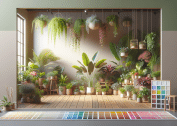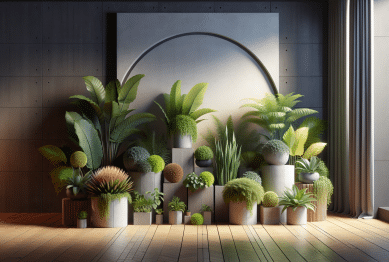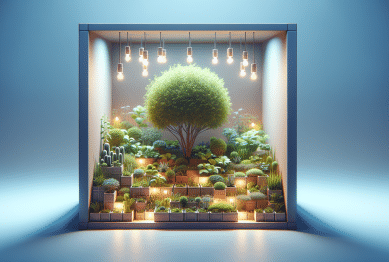Curious about how to refresh your living room without a major renovation? Explore practical, stylish tips for updating furnishings, color schemes, and layouts that bring new life to your favorite space. Learn how small decor changes may make your home feel inviting and on-trend.
Understanding Living Room Decor Trends
The living room often sits at the heart of every home, serving as a place for relaxation, socializing, and everyday living. Over time, decor trends change, inspiring people to rethink how they design this important space. Today’s popular interior design focuses on blending function with style. Techniques like mixing patterns, combining vintage and modern elements, and emphasizing comfort are shaping living room makeovers across the globe. Designers share that even subtle changes, such as updating wall colors or switching out accent pieces, can dramatically influence a room’s atmosphere. By following prevailing styles, many homeowners feel empowered to try new ideas that reflect their personality.
Minimalist trends are frequently chosen for their uncluttered and calming vibe. Neutral tones, such as whites, beiges, and subtle blues, dominate many design palettes. Layering simple textures—soft throws, plush area rugs, and woven baskets—can create a cozy environment without overcrowding the space. Meanwhile, some households lean into maximalist inspiration by displaying bold artwork, vibrant rugs, and decorative collections. Both styles often overlap, with many people experimenting to find a balance that suits their routine and tastes. Influences from global travel, eco-friendly living, and technological advancements in smart home devices continue to make their mark on current living room trends.
Color also plays a critical role in shaping first impressions. Designers suggest soft green, deep navy, or gentle blush as accent hues that inject personality without feeling overdone (Source: https://www.hgtv.com/design/decorating/design-101/living-room-color-schemes-pictures). Beyond paint, decor accents—like cushions, curtains, or artwork—allow for flexible updates. The key is to explore living room decor options that align with both function and aesthetics, resulting in a personalized yet welcoming atmosphere for anyone spending time there.
Redefining Furniture Arrangements for Comfort
Rearranging furniture can refresh the entire feel of a living room. One approach gaining popularity is floating sofas and chairs away from walls to create inviting conversation zones. This makes the most of open floor plans and encourages more natural interactions among residents and guests. Visualizing different layouts before moving heavy items can save time and reduce the trial-and-error process. Some people use online design tools or simple painter’s tape outlines to map out new positions. Thoughtful placement of each piece—like keeping coffee tables within arm’s reach and arranging lighting for balanced illumination—promotes both style and utility.
Selecting multifunctional furniture is another strategy for optimizing living room spaces. Pieces like ottomans with hidden storage, sectional sofas, or modular shelving units serve dual purposes. Not only do these choices help minimize clutter, but they also introduce opportunities for easy seasonal updates. Swapping slipcovers, rotating accent chairs, or changing media console configurations lets residents adapt their rooms for entertaining, movie nights, or quiet reading. Consulting ergonomic guidelines ensures every seat supports comfort, especially in high-use environments (Source: https://www.mghihp.edu/helpful-tips-good-ergonomics-home).
Even a small adjustment in furniture scale can improve flow. Large, bulky items may overwhelm compact rooms, while petite pieces may leave bigger areas feeling sparse. Experimenting with a mix—balancing a central statement sofa with more delicate side tables or pairing a bold coffee table with simple chairs—invites visual harmony. For those with smaller spaces, glass-topped surfaces and open shelving can keep things light and airy. By focusing on arrangement and appropriate sizing, anyone can enhance the comfort and appearance of their living room without substantial expense.
Lighting: Illuminating Spaces for Mood and Function
Lighting is key to shaping both the mood and utility of a living room. Natural sunlight can instantly enhance spaciousness, making the room feel fresh and energized. Simple updates, like using lighter curtains or adjustable blinds, allow greater control over daylight and privacy. For evenings, layered lighting—from overhead fixtures, floor lamps, and task lights—enables flexibility to suit every activity. Smart bulbs have also gained attention for letting users adjust brightness and color temperature with a phone or voice command (Source: https://www.energy.gov/energysaver/lighting-choices-save-you-money).
Ambient lighting softens harsh shadows and helps unify the decor. Consider evenly spaced ceiling lights, wall sconces, or recessed options for balanced illumination. Accent lighting—such as spotlights on artwork or backlit shelves—adds depth and draws the eye to focal points within the space. When redesigning, placing dimmers on selected fixtures gives the versatility to instantly transform the atmosphere for a party, study session, or movie viewing. Many modern designs incorporate understated light sources to highlight architectural features, like alcoves or fireplaces, making a living room feel thoughtfully curated.
For added ambiance, decorative lamps and string lights introduce soft, inviting glows in overlooked corners. These fixtures can serve as both functional sources and statement pieces that mirror the homeowner’s style. Battery-operated and plug-in options simplify installation, particularly in older homes without ample electrical outlets. By purposefully layering light, the living room may become a multi-functional, adaptable retreat for every time of day.
Textiles and Accessories: Adding Warmth With Layers
Textiles are essential for transforming the look and feel of a living room. Throw blankets, patterned pillows, and area rugs layer warmth and tactile interest onto sofas and chairs. By introducing new textures or prints, homeowners can quickly update the mood according to season or occasion. Investing in a few versatile textiles—with easy-to-clean fabrics or reversible designs—simplifies both style refreshes and household maintenance. Experts recommend selecting a primary color palette to ensure all accessories feel cohesive (Source: https://www.architecturaldigest.com/story/interior-design-tips).
Accessories add a layer of personality and finish to living room decor. Popular options include vases filled with fresh or dried flowers, decorative trays for remote controls or books, and clusters of candles for cozy, low-key lighting. Rotating small objects and art prints with the seasons can keep the room feeling fresh. Many enjoy displaying family collections, travel mementos, or framed photographs to convey personal memories. For homes with children or pets, durable throws, stain-resistant cushions, and easily washable rugs offer peace of mind and long-lasting visual appeal.
Careful display of accessories encourages both order and interest. Open shelving, grouping items in odd numbers, or using decorative baskets for storage builds visual layers without creating clutter. The thoughtful use of mirrors, metallic finishes, or glass vases can amplify daylight and create a sense of expanded space. By focusing on smart, intentional layering, any living room can be elevated to feel both comfortable and unique.
Bringing Nature Indoors: Plants and Eco-Friendly Touches
Incorporating plants is a simple, effective way to boost living room energy and air quality. Popular choices—such as monstera, fiddle-leaf fig, or snake plants—require little maintenance yet provide lush, calming greenery. Using a mix of potted floor plants and small tabletop succulents creates height and visual movement throughout the space. Even artificial plants, when chosen thoughtfully, can offer the appearance of vitality where natural sunlight is limited. Research continues to highlight the mental wellness benefits of connecting with nature, even indoors (Source: https://www.ncbi.nlm.nih.gov/pmc/articles/PMC4419447/).
Beyond foliage, eco-friendly decor elements—like bamboo trays, organic cotton throws, or reclaimed wood tables—introduce sustainability alongside beauty. Many retailers and artisans offer decor crafted from natural, recycled, or biodegradable materials, allowing homeowners to make environmentally conscious choices. Even small shifts, like repurposing vintage finds or upcycling furniture with new paint, contribute to a resourceful, planet-friendly home. Focusing on eco design trends encourages mindful purchasing and often leads to uniquely personalized living spaces.
For those interested in enhancing indoor air, consider purifying plants that have been scientifically shown to help filter common toxins. Combining greenery with simple air purification devices may further support a healthy living environment (Source: https://www.epa.gov/indoor-air-quality-iaq/inside-story-guide-indoor-air-quality). Large or small, every addition of nature—whether plant or eco-friendly furnishing—cultivates a tranquil mood and encourages everyday well-being.
Personalizing Your Living Room Without Overwhelm
Personalizing a living room can feel daunting, but a few well-chosen updates speak volumes. Start with one main element—such as a statement piece of art, a boldly patterned rug, or a signature wall color—and build from there. This focal point sets the tone and guides other design decisions, such as the choice of complementary pillows, throws, or lighting. Many lifestyle experts encourage taking inventory of existing items before purchasing new decor, ensuring that updates are intentional and compatible with the space’s current style.
For those inspired by current trends, integrating them in small doses—perhaps through new vases, lamp shades, or cushion covers—keeps the room dynamic yet cohesive. Photo ledges, gallery walls, or even floor lamps can inject personal style without permanent commitment. Trusting one’s intuition and experimenting with samples or mood boards helps narrow choices while avoiding overwhelm. It’s helpful to view decorating as an evolving process rather than a single project, making space for gradual and enjoyable changes.
Ultimately, the most inviting living rooms reflect the people who spend time there. Combining comfort, meaningful objects, and a few current trends fosters a lived-in, authentic feel. Regularly reassessing and rotating decor allows for continued discovery of fresh inspiration, ensuring the space remains both functional and full of personality over time. Home should always feel like a true reflection of those it serves.
References
1. HGTV. Living Room Color Schemes. Retrieved from https://www.hgtv.com/design/decorating/design-101/living-room-color-schemes-pictures
2. MGH Institute of Health Professions. Helpful Tips for Good Ergonomics at Home. Retrieved from https://www.mghihp.edu/helpful-tips-good-ergonomics-home
3. U.S. Department of Energy. Lighting Choices to Save You Money. Retrieved from https://www.energy.gov/energysaver/lighting-choices-save-you-money
4. Architectural Digest. Interior Design Tips for Decorating Your Home. Retrieved from https://www.architecturaldigest.com/story/interior-design-tips
5. National Institutes of Health. Interaction with indoor plants may reduce psychological and physiological stress. Retrieved from https://www.ncbi.nlm.nih.gov/pmc/articles/PMC4419447/
6. U.S. Environmental Protection Agency. The Inside Story: A Guide to Indoor Air Quality. Retrieved from https://www.epa.gov/indoor-air-quality-iaq/inside-story-guide-indoor-air-quality











 Unlocking Success with Your First Rental Property
Unlocking Success with Your First Rental Property 

